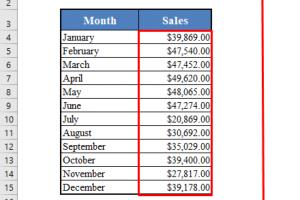Mastering Excel: The Ultimate Guide to Adding Numbers & Cells Effortlessly

-
Quick Links:
- Introduction
- Understanding Excel
- Adding Numbers in Excel
- Adding Cells in Excel
- Using Excel Formulas for Addition
- Case Studies & Real-World Applications
- Expert Insights
- Common Mistakes to Avoid
- Tips and Tricks for Efficient Use
- FAQs
Introduction
In today’s data-driven world, mastering Excel is a necessity for professionals across various fields. Whether you are managing budgets, analyzing data, or creating reports, knowing how to add numbers and cells effectively is crucial. This guide will provide you with a step-by-step approach to adding numbers and cells in Excel, accompanied by examples, case studies, and expert insights.
Understanding Excel
Microsoft Excel is a powerful spreadsheet software widely used for data management and analysis. It consists of rows and columns, which create cells where you can input data. Understanding the basic layout and functionalities of Excel is the first step toward mastering it.
Excel Basics
- Cells: The intersection of rows and columns. Each cell can contain text, numbers, or formulas.
- Worksheet: A single tab in an Excel file where you can enter and manipulate data.
- Workbook: An Excel file that can contain multiple worksheets.
Adding Numbers in Excel
Adding numbers in Excel can be done in several ways. Here, we will explore the most common methods.
Method 1: Using the Plus Operator (+)
The simplest way to add numbers in Excel is by using the plus operator. Here’s how:
- Click on the cell where you want the result to appear.
- Type the formula: =A1 + A2 (replace A1 and A2 with your cell references).
- Press Enter.
Method 2: Using the SUM Function
The SUM function is more efficient for adding large ranges of numbers.
=SUM(A1:A10)This formula will add all numbers from cells A1 to A10.
Method 3: AutoSum Feature
Excel's AutoSum feature automatically adds numbers in a column or row.
- Select the cell directly below the column of numbers you want to sum.
- Click on the AutoSum button (Σ) in the toolbar.
- Press Enter.
Adding Cells in Excel
Adding the content of entire cells can be done using various methods.
Method 1: Direct Addition
You can use the same methods as adding numbers, but you can also concatenate text and numbers:
=A1 & " " & A2This will combine the contents of A1 and A2 separated by a space.
Method 2: Using the CONCATENATE Function
The CONCATENATE function allows for more complex combinations:
=CONCATENATE(A1, " ", A2)Using Excel Formulas for Addition
Excel formulas are powerful tools that allow you to automate calculations. Here are a few essential formulas for adding numbers:
Common Formulas
- SUMIF: Adds cells based on given criteria.
- SUMPRODUCT: Multiplies corresponding components in the given arrays and returns the sum.
Case Studies & Real-World Applications
Understanding practical applications can enhance your Excel skills. Here are a few scenarios:
Case Study 1: Budget Management
A financial analyst uses Excel to track monthly expenses, using SUM functions to calculate totals quickly.
Case Study 2: Sales Data Analysis
A sales manager uses SUMIF to analyze performance across different regions and products.
Expert Insights
Experts recommend regularly practicing Excel functions to gain proficiency. Utilize Excel’s built-in help features and online tutorials for ongoing learning.
Common Mistakes to Avoid
- Forgetting to use the equal sign when starting a formula.
- Incorrectly referencing cell ranges.
- Not double-checking results for errors.
Tips and Tricks for Efficient Use
- Use keyboard shortcuts for faster navigation.
- Familiarize yourself with Excel’s functions and features.
- Keep your data organized for easier analysis.
FAQs
- How do I add numbers in Excel?
Use the plus operator (+), the SUM function, or the AutoSum feature. - Can I add cells with text and numbers?
Yes, use the & operator or the CONCATENATE function. - What is the difference between SUM and SUMIF?
SUM adds all numbers in a range, while SUMIF adds numbers based on specified criteria. - How do I fix errors in my Excel formulas?
Check cell references, ensure all parentheses are closed, and confirm data types are correct. - Can I automate addition in Excel?
Yes, use Excel formulas and functions to automate calculations. - What should I do if my numbers are not adding up?
Check for hidden cells, formatting issues, or incorrect formulas. - Is there a limit to how many cells I can add together?
No, but performance may slow down with very large datasets. - How can I learn more about Excel?
Utilize online courses, tutorials, and Excel's built-in help features. - Can I use Excel on my mobile device?
Yes, Microsoft offers a mobile version of Excel with similar functionalities. - What are some good Excel resources?
Check out Microsoft’s official documentation, online forums, and tutorial websites.
Random Reads
- How to check data usage on att
- How to join minecraft minigame servers
- How to join advanced server mlbb
- How to find latias in pokemon emerald
- How to find latios pokemon emerald
- How to find internal external ip address mac
- How to find imei or meid number
- How to check identify ipod generation
- How to check free hard disk space
- Open view kml files google earth